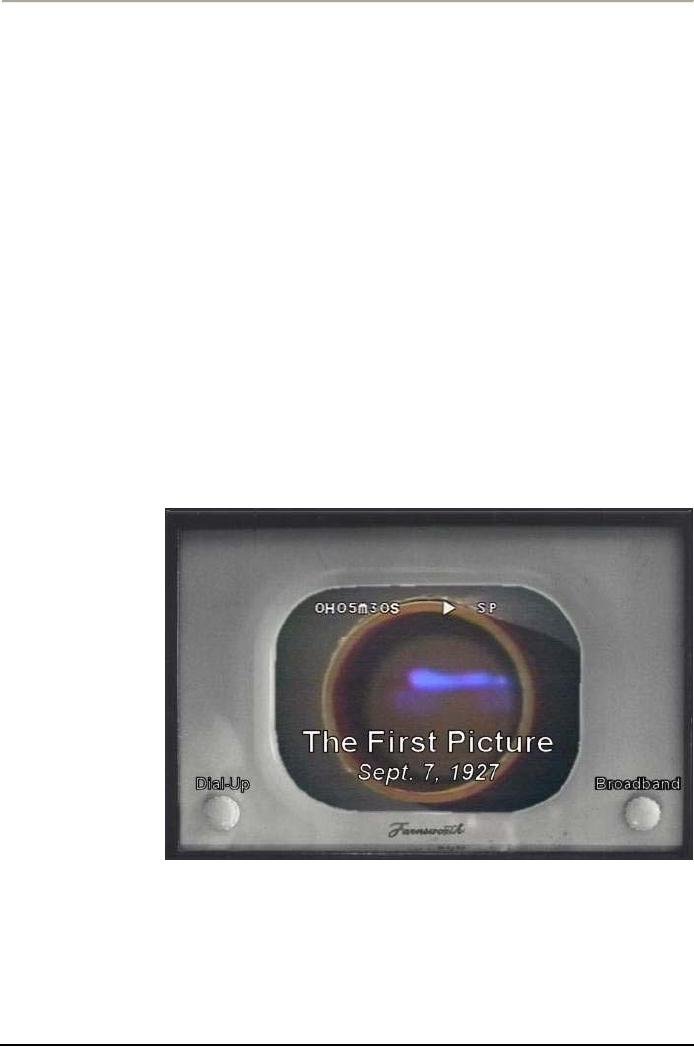 |

Introduction
to Broadcasting MCM
411
VU
LESSON
23
HISTORY OF
TELEVISION
The
electronic way of communication
was quite well known by
the start of the 20th
century
but
in
almost all cases it was
limit to sending or receiving
voice messages. Since
most
researchers
and scientists were focusing
on the voice transmission,
the radio broadcast
resulted
almost simultaneously in many
parts of the world with
the exception of a difference
of
few
years. The name of Marconi,
however, stands distinguished in
the eyes of many as
the
inventor
of radio.
The
inventor of television, the
device responsible for
receiving voice as well as
images, is
John
Logie Baird of Scotland. Controversy,
however, surrounds the
matter to mark as who
really
invented the television.
Most historians have settled
the issue by reaching
the
conclusion
that it is an outcome of many
scientists who worked on
different areas of
this
outstanding
device, which, ever since
its inception, has been
bringing about so many
social,
cultural
and economic changes - and
that too with rapid
speed, and is considered as
one
major
factor to help globalize
human thinking and
understanding on various matters by
fully
exploiting
all the elements possible in
visual communication, or say
broadcasting.
Here
below we will make an
attempt to see TV history
and various stages, it has
scaled so far.
Early
History
Although
the Scotsman John
Logie Baird is generally
considered to be the creator
of
television,
it remains a challenging job
about television history
from where exactly to
begin.
Most
inventions begin with a
vision and so for the
sake of argument we can
begin our story as
far
back as 1869. For that
was the year that
the French artist Albert
Robida, published a
picture
of a man, reclining in an armchair in
the comfort of his own
home, And this more
than
two
decades before the American
inventor Thomas Alva Edison
had caught one of
his
assistants,
Fred Ott, sneezing on
camera, which was then
copyrighted as 'Record of a
Sneeze', on 7th
January 1894. But whilst
scientists and photographers
the world-over had
been
trying to invent the movies
for years, television had
its own definite
requirements, and
these
were not the result of a
single discovery, but of
successive and
independent
developments.
The
discovery of a material known as
selenium is said to be very
important, if we have to
begin
from somewhere.
In
1817 the Swedish scientist
Berzelius discovered selenium, a
metalloid in the oxygen
group
with
electrical properties. But it
wasn't until 1873 that a
telegraph operator named
Joseph May
discovered
the photosensitive properties of
selenium which led to the
possibility of converting
light
waves into electrical
impulses. But it wasn't
until 1881 that another
American, Shelford
Bidwell,
demonstrated a method for
transmitting silhouettes. Paul
Nipkov's disc scanner
made
use
of the selenium cell, but
like other inventors and
demonstrators around that
time his
equipment
lacked the means of
amplifying the
impulses.
Karl
Ferdinand Braun introduced
the first cathode-ray tube
for commercial use in 1897
and
four
years later Dr Ambrose
Fleming patented the
two-diode thermionic valve.
After this there
was
little in the way of public
recognized progress until
1923 when a number of
scientists in
55

Introduction
to Broadcasting MCM
411
VU
the
US, France and England
had progressed to the point
where they were able to
transmit
shadows.
It's
at this point, that Baird
came onto the scene in a
big way. Although he had
been
developing
his own methods of televised
images for many years, it
was in 1924 that he
first
demonstrated
a mechanically scanned television
system which transmitted
objects in outline
and
went on the following year
to show the head of a dummy,
not just in outline but as a
real
image.
Since
the time of Baird, the
dizzyingly rapid development of
the medium of television
has
taken
many of the disparate
elements chanced upon by
those early, far-sighted,
pioneers and
consolidated
them into a unified whole
which has arguably become
one of the key
cornerstones
of modern society.
Viewed
with the benefit of perfect
hindsight, the beginning and
subsequent rise of
television
can
now be appreciated as a complex
mosaic of inspired individuals. A
vision, which
ultimately
combined to form a cohesive
foundation for one of the
most important and
far
reaching
invention in human
history.
The
Black & White
Images:
Though
many companies patented the
new technology in their
respective countries, the
world
saw
an unusual interest in the
black and white programs
which normally consisted of
the
filmed
music, live chats
announcements and news.
Since TV transmission was
very limited in
covering
distance, only urban
population was there to
enjoy early days of TV
life.
THE
World War II
The
sudden
outbreak
of World
War
II halted to
some
extent
progress
on TV
transmissions
and
improvement
in
technological
advancement
in
making
TV
a
household
item for
most.
The B/W
limited
scale TV
transmission
continued
to excite
people.
The images
of
war ridden and
ravaged
sites on mini screens of
old-fashioned TV sets would
pull crowd to watch those
and
get
influenced by the devastation of
the mad war. Seeing is
believing, worked to make
people
understand
as who was winning the
war and who was
controlling the noted and
known cities
at
different stages of the
years long fighting. It was
a sight not to be forgotten
for those who
first
witnessed defeat of German
armies at different fronts
and marching of the allied
forces on
the
German land towards the
last days of the
war.
56

Introduction
to Broadcasting MCM
411
VU
Color
Television
A
German patent in 1904
contained the earliest
recorded proposal for a
color television
system.
In 1925, Zworykin, a scientist,
filed a patent disclosure
for an all-electronic
color
television
system. Both of these
systems were not successful,
however, they were the
first for
color
television.
"Between
1946 and 1950 the
research staff of RCA
Laboratories invented the
world's first
electronic,
monochrome compatible, color
television system."
In
1940, prior to RCA, CBS
researchers led by Peter
Goldmark invented a mechanical
color
television
system based on the 1928
designs of John Logie Baird.
The FCC authorized
CBS's
color
television technology as the
national standard in October
1950, despite the fact
that the
system
was bulky, flickered, and
was not compatible with
earlier black and white
sets. Color
television
production was halted during
the Korean war in the
early years of the
50s.
Those
factors provided RCA,
manufacturers of TV sets, with
the time to design a better
color
television.
Their system passed FCC
approval in late 1953 and
sales of RCA color
televisions
began
in 1954.
In
December of 1954, RCA
introduced their 21" color
TV. Although the number
recorded in
history
books is 5,000 units sold,
the common belief (amongst
collectors) is that the
actual
number
sold to the public was
considerably less.
1950-1959
was an exciting time period
for television. In the USA,
B&W television exploded
onto
the scene at the beginning
of the decade, mid-decade saw
electronic color television
and
remote
controls launched, and at
the end of the decade
the public witnessed some
interesting
styling
changes and the introduction
of transistorized television.
Nature
of Programs
TV
took most of its program
patterns from radio.
Classification of its transmission
has been
made
in the following
manner;
�
News
�
Music
�
Films
�
Comedy
shows
�
Live
shows
�
Sports
The
Cultural Revolution
There
have been changes in the
lifestyle of societies which
have been brought about by
the
introduction
of TV broadcast. The following
factors helped take TV
broadcast across the
world
and
effect changes in the living
style of people;
Tourism
57

Introduction
to Broadcasting MCM
411
VU
Languages
Immigration
policies
Education
The
Transmission Systems
Since
a range of technical advancement on
some different lines was
available when TV
transmission
was introduced in 40s and
50s in different countries,
there are still
different
systems
which operate the whole
functions of transmission and
receiving TV signals.
Here
below is some detail of
various valid systems, and a
chart of countries showing
the
system
they allowed for TV
transmission.
The
table
below
shows
the
type
of
television
broadcast
standard
used
in most countries around the
world.
There
are currently 3 main
television standards used
throughout the world:
NTSC
- National
Television
Standards
Committee.
The oldest existing
standard, developed in
the
USA. First used in 1954,
consists of 525 horizontal
lines of display and 60
vertical lines.
SECAM
- Syst�me
�lectronique
pour Couleur
avec
M�moire.
Developed in France. First
used
in
1967. A 625-line vertical,
50-line horizontal
display.
PAL
- Phase
Alternating
Line.
Developed by German engineer
Walter Bruch and the
German
electronic
corporation Telefunken. Walter
Bruch patented his invention
in 1963 and the
first
commercial
application of the PAL system in
August 1967. Also a
625/50-line display
and
alternative
of NTSC. Proponents call it
"Perfection
At
Last."
Television
Standards by Country:
COUNTRY
SIGNAL
TYPE
AFGHANISTAN
PAL
B, SECAM B
ALBANIA
PAL
B/G
ALGERIA
PAL
B/G
ANGOLA
PAL
I
ANTARCTICA
NTSC
M
ANTIGUA
& BARBUDA
NTSC
M
ARGENTINA
PAL
N
ARMENIA
SECAM
D/K
ARUBA
NTSC
M
58

Introduction
to Broadcasting MCM
411
VU
AUSTRALIA
PAL
B/G
AUSTRIA
PAL
B/G
AZERBAIJAN
SECAM
D/K
AZORES
PAL
B
BAHAMAS
NTSC
M
BAHRAIN
PAL
B/G
BANGLADESH
PAL
B
BARBADOS
NTSC
M
BELARUS
SECAM
D/K
BELGIUM
PAL
B/H
BELGIUM
(ARMED FORCES
NETWORK)
NTSC
M
BELIZE
NTSC
M
BENIN
SECAM
K
BERMUDA
NTSC
M
BOLIVIA
NTSC
M
BOSNIA/HERZEGOVINA
PAL
B/H
BOTSWANA
SECAM
K, PAL I
BRAZIL
PAL
M
BRITISH
INDIAN OCEAN
TERRITORY
NTSC
M
(AF
DIEGO GARCIA TV -
AFRTS)
BRUNEI
DARUSSALAM
PAL
B
BULGARIA
PAL
BURKINA
FASO
SECAM
K
BURUNDI
SECAM
K
CAMBODIA
PAL
B/G, NTSC M
CAMEROON
PAL
B/G
CANADA
NTSC
M
CANARY
ISLANDS
PAL
B/G
CENTRAL
AFRICAN REPUBLIC
SECAM
K
59

Introduction
to Broadcasting MCM
411
VU
CHAD
SECAM
D
CHILE
NTSC
M
CHINA
(PEOPLE'S REPUBLIC)
PAL
D
COLOMBIA
NTSC
M
CONGO
(PEOPLE'S REPUBLIC)
SECAM
K
CONGO,
DEM. REP. (ZAIRE)
SECAM
K
COOK
ISLANDS
PAL
B
COSTA
RICA
NTSC
M
COTE
D'IVOIRE (IVORY
COAST)
SECAM
K/D
CROATIA
PAL
B/H
CUBA
NTSC
M
CYPRUS
PAL
B/G
CZECH
REPUBLIC
PAL
B/G (cable), PAL D/K
(broadcast)
DENMARK
PAL
B/G
DIEGO
GARCIA
NTSC
M
DJIBOUTI
SECAM
K
DOMINICA
NTSC
M
DOMINICAN
REPUBLIC
NTSC
M
EAST
TIMOR
PAL
B
EASTER
ISLAND
PAL
B
ECUADOR
NTSC
M
EGYPT
PAL
B/G, SECAM B/G
EL
SALVADOR
NTSC
M
EQUITORIAL
GUINEA
SECAM
B
ESTONIA
PAL
B/G
ETHIOPIA
PAL
B
FALKLAND
ISLANDS (LAS
MALVINAS)
PAL
I
FIJI
NTSC
M
FINLAND
PAL
B/G
60

Introduction
to Broadcasting MCM
411
VU
FRANCE
SECAM
L
FRANCE
(FRENCH FORCES TV)
SECAM
G
GABON
SECAM
K
GALAPAGOS
ISLANDS
NTSC
M
GAMBIA
PAL
B
GEORGIA
SECAM
D/K
GERMANY
PAL
B/G
GERMANY
(ARMED FORCES TV
GERMANY)
NTSC
M
GHANA
PAL
B/G
GIBRALTAR
PAL
B/G
GREECE
PAL
B/G
GREENLAND
PAL
B
GRENADA
NTSC
M
GUAM
NTSC
M
GUADELOUPE
SECAM
K
GUATEMALA
NTSC
M
GUIANA
(FRENCH)
SECAM
K
GUINEA
PAL
K
GUYANA
NTSC
M
HAITI
SECAM
HONDURAS
NTSC
M
HONG
KONG
PAL
I
HUNGARY
PAL
K/K
ICELAND
PAL
B/G
INDIA
PAL
B
INDONESIA
PAL
B
IRAN
PAL
B/G
IRAQ
PAL
IRELAND,
REPUBLIC OF
PAL
I
61

Introduction
to Broadcasting MCM
411
VU
ISLE
OF MAN
PAL
ISRAEL
PAL
B/G
ITALY
PAL
B/G
JAMAICA
NTSC
M
JAPAN
NTSC
M
JOHNSTONE
ISLAND
NTSC
M
JORDAN
PAL
B/G
KAZAKHSTAN
SECAM
D/K
KENYA
PAL
B/G
KOREA
(NORTH)
SECAM
D, PAL D/K
KOREA
(SOUTH)
NTSC
M
KUWAIT
PAL
B/G
KYRGYZ
REPUBLIC
SECAM
D/K
LAOS
PAL
B
LATVIA
PAL
B/G, SECAM D/K
LEBANON
PAL
B/G
LESOTHO
PAL
K
LIBERIA
PAL
B/H
LIBYA
PAL
B/G
LIECHTENSTEIN
PAL
B/G
LITHUANIA
PAL
B/G, SECAM D/K
LUXEMBOURG
PAL
B/G, SECAM L
MACAU
PAL
I
MACEDONIA
PAL
B/H
MADAGASCAR
SECAM
K
MADEIRA
PAL
B
MALAYSIA
PAL
B
MALDIVES
PAL
B
MALI
SECAM
K
62

Introduction
to Broadcasting MCM
411
VU
MALTA
PAL
B
MARSHALL
ISLANDS
NTSC
M
MARTINIQUE
SECAM
K
MAURITANIA
SECAM
B
MAURITIUS
SECAM
B
MAYOTTE
SECAM
K
MEXICO
NTSC
M
MICRONESIA
NTSC
M
MIDWAY
ISLAND
NTSC
M
MOLDOVA
(MOLDAVIA)
SECAM
D/K
MONACO
SECAM
L, PAL G
MONGOLIA
SECAM
D
MONTSERRAT
NTSC
M
MOROCCO
SECAM
B
MOZAMBIQUE
PAL
B
MYANMAR
(BURMA)
NTSC
M
NAMIBIA
PAL
I
NEPAL
B
NETHERLANDS
PAL
B/G
NETHERLANDS
(ARMED FORCES
NETWORK)
NTSC
M
NETHERLANDS
ANTILLES
NTSC
M
NEW
CALEDONIA
SECAM
K
NEW
ZEALAND
PAL
B/G
NICARAGUA
NTSC
M
NIGER
SECAM
K
NIGERIA
PAL
B/G
NORFOLK
ISLAND
PAL
B
NORTH
MARIANA ISLANDS
NTSC
M
NORWAY
PAL
B/G
63

Introduction
to Broadcasting MCM
411
VU
OMAN
PAL
B/G
PAKISTAN
PAL
B
PALAU
NTSC
M
PANAMA
NTSC
M
PAPUA
NEW GUINEA
PAL
B/G
PARAGUAY
PAL
N
PERU
NTSC
M
PHILIPPINES
NTSC
M
POLAND
PAL
D/K
POLYNESIA
(FRENCH)
SECAM
K
PORTUGAL
PAL
B/G
PUERTO
RICO
NTSC
M
QATAR
PAL
B
REUNION
SECAM
K
ROMANIA
PAL
D/G
RUSSIA
SECAM
D/K
ST.
KITTS & NEVIS
NTSC
M
ST.
LUCIA
NTSC
M
ST.
PIERRE ET MIQUELON
SECAM
K
ST.
VINCENT
NTSC
M
SAO
TOM� E PRINCIPE
PAL
B/G
SAMOA,
AMERICAN
NTSC
SAUDI
ARABIA
SECAM
B/G, PAL B
SAMOA
NTSC
M
SENEGAL
SECAM
K
SEYCHELLES
PAL
B/G
SIERRA
LEONE
PAL
B/G
SINGAPORE
PAL
B/G
SLOVAKIA
PAL
B/G
64

Introduction
to Broadcasting MCM
411
VU
SLOVENIA
PAL
B/H
SOMALIA
PAL
B/G
SOUTH
AFRICA
PAL
I
SPAIN
PAL
B/G
SRI
LANKA
PAL
SUDAN
PAL
B
SURINAME
NTSC
M
SWAZILAND
PAL
B/G
SWEDEN
PAL
B/G
SWITZERLAND
PAL
B/G
SYRIA
SECAM
B, PAL G
TAHITI
SECAM
TAIWAN
NTSC
TAJIKISTAN
SECAM
D/K
TANZANIA
PAL
B
THAILAND
PAL
B/M
TOGO
SECAM
K
TRINIDAD
& TOBAGO
NTSC
M
TUNISIA
SECAM
B/G
TURKEY
PAL
B
TURKMENISTAN
SECAM
D/K
TURKS
& CAICOS ISLANDS
NTSC
M
UGANDA
PAL
B/G
UKRAINE
SECAM
D/K
URUGUAY
PAL
N
UNITED
ARAB EMIRATES
PAL
B/G
UNITED
STATES
NTSC
M
UNITED
KINGDOM
PAL
I
UZBEKISTAN
SECAM
D/K
65

Introduction
to Broadcasting MCM
411
VU
VENEZUELA
NTSC
M
VIETNAM
NTSC
M,SECAM D
VIRGIN
ISLANDS (US &
BRITISH)
NTSC
M
WALLIS
& FUTUNA
SECAM
K
YEMEN
PAL
B/NTSC M
YUGOSLAVIA
PAL
B/G
ZAMBIA
PAL
B/G
ZIMBABWE
PAL
B/G
66
Table of Contents:
- BROADCASTING:Historical Facts about Radio, Wireless and Radio
- CLASSIFICATION OF PROGRAMS:NEWS, Language, Sensationalizing
- CURRENT AFFAIRS:Talk Shows, Discussions, Seminars, Live Shows
- OUTDOOR BROADCASTING I:VIP Movement, Suddenly Assigned Events
- OUTDOOR BROADCASTING II:Pakistan Day March Past, General Elections
- CURTAIN RAISER:Political, Financial, Sports, Academics
- RADIO FEATURE:Personality Features, Features on Events
- MUSICAL PROGRAMS:Classical Music, Light and Film Music, Folk Music
- RADIO DOCUMENTARY:Narrative, Dramatized, Imagination, Close to places
- DISC JOCKEY:Women in Focus, Daily/ Weekly Division, Making Titles
- VOICE IN BROADCASTING:Speech, Accent, Loudness, Stress
- NOISE:Physical, Medium itself, Problem at sender’s end, Semantics
- STUDIO:Drama Studio, Studios for Talk Shows/ Discussions, Music Studios,
- RADIO DRAMA I:Stage Dramas, Early Radio Dramas, Ethics, Classification
- RADIO DRAMA II:Selection of director, The Playwrights, Script, Voices
- ADVERTISEMENT – INCOME GENERATION:Similarities, More Analysis
- ADVERTISERS’ APPROACH:Dramatized, Dialogue based, News
- FM – A NEW GENERATION IN BROADCASTING:Low Cost, The Difference
- MICROPHONE TO TRANSMITTER:Amplifiers, Modulator, Transmitter
- WRITING SCRIPT FOR RADIO BROADCAST:NEWS Script, Interviews
- INTERACTIVE BROADCASTING:On-line, E-mails, Interview, Views in News
- REVISION:CURRENT AFFAIRS, RADIO FEATURE, MUSICAL PROGRAMS
- HISTORY OF TELEVISION:Early History, The Black & White Images, Color Television
- PAKISTAN TELEVISION (PTV):The Excitement, Timing, Live Broadcast
- BROADCASTING LAWS:Laws in the 19th century, Press Council of Pakistan
- REPLICAS OF RADIO BROADCAST:The Staff, News Reading, Programming
- NEW SCRIPT WRITING AND DIRECTION TECHNIQUES:TV Script
- SETS:Permanent Sets, Hot & Cover Sets, Special Sets, Economical
- CAMERA SHOTS – THE VISUAL LANGUAGE:Angle Shots, Movement shots
- LIGHTS IN VISUAL BROADCASTING:Light Temperature, Light and Distance
- INTERIOR AND EXTERIOR:NEWS and Interviews, Dramas and Music
- BROADCASTING AND MEDIA IMPERIALISM:The truth in the debate
- ENVIRONMENT OF TV BROADCAST:Optical Illusions, POV, Depth of Field
- BUDGET:First Part, Second Part, Third Part, The Sponsors
- COMPARISON AND CONTRAST OF DIFFERENT RADIO AND TV FORMATS:TV NEWS
- CURRENT AFFAIRS – FROM RADIO TO TV:Seminars, Interviews
- PRE-PRODUCTION:Brain Storming, Scripting a new program, Approval
- PRODUCTION & POST-PRODUCTION:Booking Shifts, Rehearsals
- TV ADVERTISEMENTS – MONEY WITH ENTERTAINMENT:Early Phase, Getting Spots
- ENIGMA OF MORE CHANNELS:The Investment, Fresh Ideas, Closure of channels
- ANCHORPERSON:Appearance and Confidence, Job Opportunities
- COMPARISON BETWEEN RADIO AND TV BROADCAST:The Difference, Script
- TERRESTRIAL TO SATELLITE TO CABLE TV:Cable Network, CD Channels
- CAREER IN BROADCASTING:Production, Direction, Lighting Director, Script Writer
- REVISION (LESSON 23 TO 44):Broadcasting Laws, PEMRA, Budget